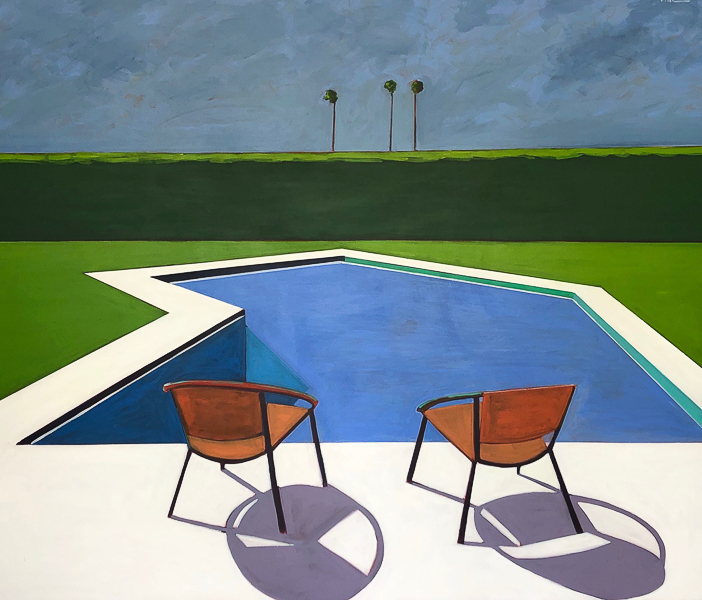1.
El tema «Bad woman blues», de Beth Hart.
2.
La obra «Pool with orange chairs», de Melissa Chandon.

3.
El poema de Andrés Neuman, «La natación y el aire», publicado originalmente en el periódico de poesía limeño estruendomundo, en su edición de marzo de 2004.
«En eras primitivas,
cuando el verbo aguardaba sumergido,
los peces respiraban a través de una vesícula
que era a la vez timón, brújula y bronquio,
fuente del equilibrio natatorio
y del aire disperso por el agua.
Hoy perviven, mermadas en las profundidades,
unas pocas especies que la emplean.
En nosotros también resiste un testimonio:
iquién no ha sentido, en sueños, que volaba
como si diera brazas en el mar?
Al dormir, respiramos con el órgano
extraño que los peces han perdido,
el mismo que alza a flote las imágenes,
y el ritmo del pulmón decide el vuelo
-su altura, su sentido, sus virajes-
y sudamos en busca de un líquido remoto
y levamos el cuerpo como quien muta en pájaro.
Mientras esto suceda, mientras haya
sueños y voluntad de reflotarlos,
memoria y reflexiones abisales,
fusiones de elementos y de ciclos,
vivirá la poesía. En el futuro
volar será nadar con más conciencia.»
4.
El artículo de Robert Rubsam para Bandcamp, «A guide to the wild expanse of Cosmic American Music». Aquí.
Un extracto:
«Gram Parsons is generally credited with the invention of “Cosmic American Music”—blues, country, and rock all rolled into one sparkling package. Then again, Gram Parsons also referred to what he’d wrought as a “‘country-rock’ plastic dry-fuck.” Still, it’s fair to situate Parsons somewhere near the head of the reinvigoration of American roots music that began in the mid ’60s, spearheaded by The Band and reaching its commercial peak with a series of country rock acts in the mid-to-late ‘70s. During this time, a good many performers found success combining the clarity of country with funk, blues, and R&B grooves, with the Muscle Shoals house band backing Aretha Franklin, the Allman Brothers selling out the Fillmore East, and J.J. Cale setting blues to drum machines.
These were artists that drew on a wide variety of American musical traditions and fused them into something vibrant, new, and exciting. At the same time, fingerpickers like Robbie Basho and John Fahey were reinventing vernacular guitar styles into what would later be called American Primitivism, and a good many semi-anonymous acts, immortalized on Light in the Attic’s Country Funk series, took the outlaw credo to its hip-shaking limits. This was American music in the broadest sense of the word, even if not quite all of its performers were American (see: Neil Young, Robbie Robertson, Buffy Sainte-Marie).
We’ve seen many Americana revivals in the time since, whether the roots-rock scene of the ‘80s or the O Brother, Where Art Thou?-inspired traditionalism at the turn of the century. These musicians are less easy to define as part of a movement, but share a common ground nonetheless. They’re mostly individuals, scattered throughout the country, with minimal commercial success. Their music has been collected on a handful of great labels (Scissor Tail in Tulsa, Paradise of Bachelors in Chapel Hill, Drag City in Chicago), each with a slightly different focus. But that glorious, syncretic impulse remains among them all, fusing folklore to funk, raga to R&B, in service all of some grand American musical vision.»
5.
El artículo de Allison P. Davis para The Cut «How did a datting app become my longest running relationship?» donde cuenta sus diez años de experiencia usando Tinder.
Aquí.
Un extracto:
«I’ve rejected people for bad grammar, racial slurs, boring first questions, aggressive and immediate sexual overtures, overly earnest chat, GIF usage, delay of IRL meeting, or an inexplicable ick, often involving their choice in footwear. I’ve forgotten I dated and slept with someone and rematched with renewed interest. I’ve been lightly catfished and probably almost scammed. I’ve received dick pics without warning, solicited dick pics, sent nudes. It never occurred to me some specifics would turn me on: a snaggletooth, a bad tattoo in a good location, clean fingernails. I’ve ghosted and been ghosted and taken all the rejection like a champ but then been so randomly, disproportionately felled by one single rejection I’m surprised at the intensity of my rage and despair. I’ve been lucky that I’ve never had anything truly bad happen to me.
I’ve deleted the app and redownloaded the app, deleted and done it again. I’ve had so many long-term text-only encounters that for a moment I wondered if I was a digisexual. I’ve strayed and used Hinge (why don’t I get any matches?) and Bumble (just because I can message first doesn’t mean you’ll message back) and Raya (C-LIST CELEB WITH ACCESS TO A PI, CAN YOU PLEASE?), and I once downloaded something called Headero, but I’ve always come back to Tinder. I’ve had a lot of fun. I’ve run out of matches on more than one occasion. I’ve never made it to a fifth date, which means the longest-term relationship I’ve had from Tinder is with Tinder itself.»